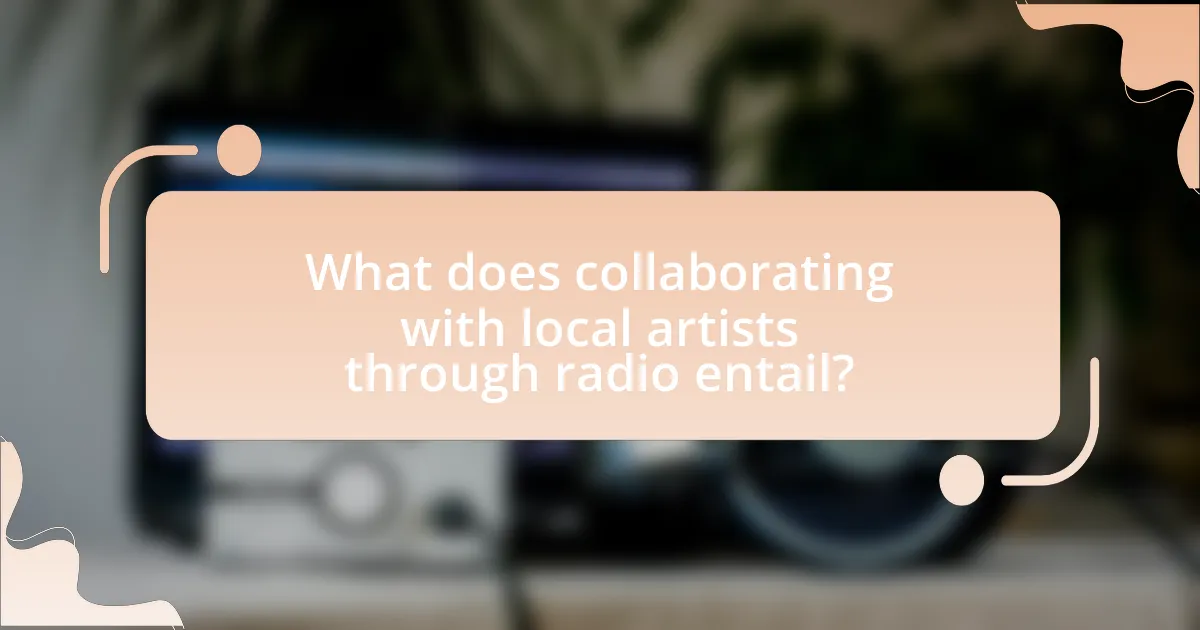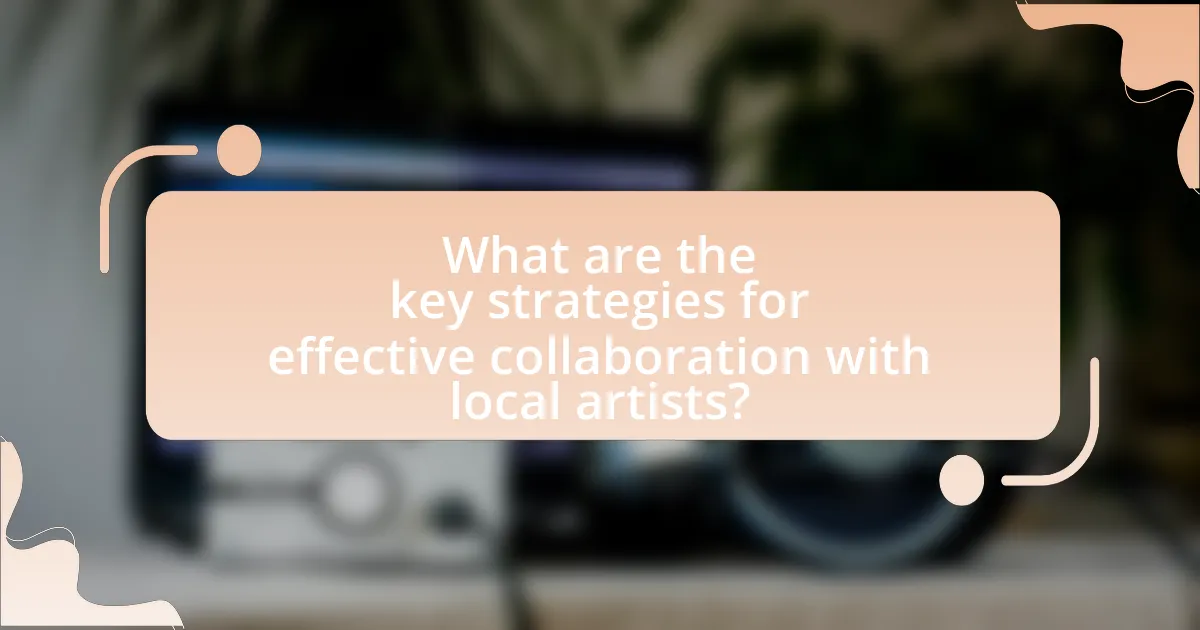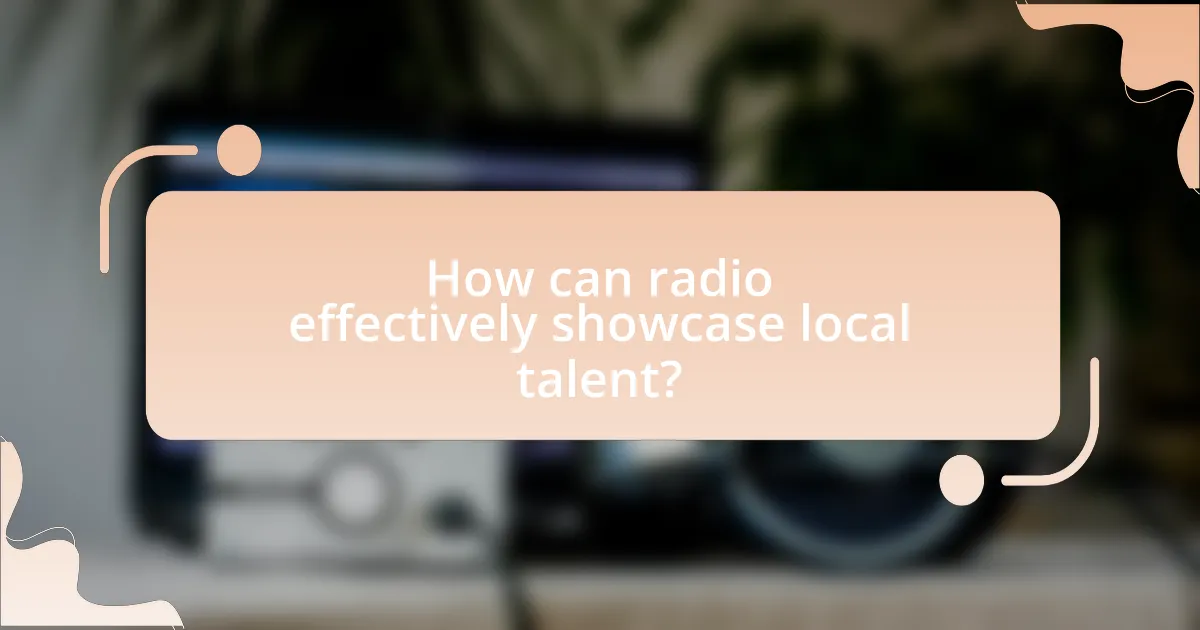Collaborating with local artists through radio involves creating a platform for musicians to share their music and stories, enhancing community engagement and visibility. This collaboration includes live interviews, music showcases, and dedicated segments that highlight local talent, ultimately fostering a supportive environment for artists. Key strategies for effective collaboration include clear communication, mutual respect, and shared goals, while radio serves as a vital tool for reaching diverse audiences and promoting local artists. The article explores the benefits of such collaborations, the types of content that can be created, and the challenges that may arise, providing insights into how radio stations can effectively support and showcase local talent.

What does collaborating with local artists through radio entail?
Collaborating with local artists through radio entails creating a platform for artists to share their music, stories, and creative processes with a broader audience. This collaboration often includes live interviews, music showcases, and promotional segments that highlight the artists’ work. For instance, community radio stations frequently engage with local musicians to feature their tracks, thereby fostering a sense of community and supporting the local arts scene. Such initiatives can lead to increased visibility for artists, as evidenced by studies showing that local radio exposure can significantly boost an artist’s fan base and streaming numbers.
How can radio serve as a platform for local artists?
Radio serves as a platform for local artists by providing them with exposure to a wider audience through airplay of their music and interviews. Local radio stations often prioritize community engagement, allowing artists to share their work, stories, and upcoming events directly with listeners. For instance, many stations feature dedicated segments for local talent, such as “Local Artist Spotlight,” which can significantly increase an artist’s visibility and fan base. Additionally, radio can facilitate networking opportunities, connecting artists with industry professionals and other musicians, thereby fostering collaboration and growth within the local music scene.
What types of content can be created to showcase local talent?
Various types of content can be created to showcase local talent, including interviews, live performances, artist spotlights, and collaborative projects. Interviews allow for in-depth discussions about the artist’s background and creative process, while live performances provide an immediate experience of their work. Artist spotlights can feature curated playlists or segments highlighting their best pieces, and collaborative projects can involve partnerships with local businesses or events to promote the talent within the community. These content types effectively engage audiences and foster a connection between local artists and listeners.
How does radio reach diverse audiences for local artists?
Radio reaches diverse audiences for local artists by providing a platform that broadcasts music and interviews across various demographics. Local radio stations often curate playlists that include a mix of genres, appealing to different cultural backgrounds and age groups. Additionally, radio hosts frequently engage with the community by featuring local artists, promoting events, and conducting interviews, which fosters a sense of connection and relevance. According to a 2021 Nielsen report, 92% of Americans listen to radio each week, highlighting its extensive reach and ability to connect with a broad audience. This accessibility allows local artists to gain exposure and build a fan base within their communities.
Why is collaboration important for local artists?
Collaboration is important for local artists because it fosters creativity, expands their audience, and enhances their skill sets. When local artists work together, they can share diverse perspectives and techniques, leading to innovative artistic expressions. Additionally, collaboration allows artists to tap into each other’s networks, thereby reaching a broader audience and increasing visibility. For instance, a study by the National Endowment for the Arts found that collaborative projects often result in higher engagement levels from the community, which can significantly benefit local artists by creating more opportunities for exposure and sales.
What benefits do local artists gain from radio collaborations?
Local artists gain increased exposure and credibility from radio collaborations. By partnering with radio stations, artists can reach wider audiences, as radio broadcasts can attract listeners who may not be familiar with their work. This exposure often leads to increased fan engagement and potential sales of music or merchandise. Additionally, radio collaborations can enhance an artist’s reputation, as being featured on established platforms lends legitimacy to their craft. According to a study by the National Endowment for the Arts, artists who engage with media platforms, including radio, report higher visibility and opportunities for live performances, further solidifying the benefits of such collaborations.
How does collaboration enhance community engagement?
Collaboration enhances community engagement by fostering a sense of belonging and shared purpose among participants. When local artists collaborate with community members, they create opportunities for dialogue, creativity, and mutual support, which strengthens social ties. Research indicates that collaborative projects, such as community art initiatives, can increase participation rates by up to 50%, as they invite diverse voices and perspectives into the creative process. This inclusivity not only enriches the artistic output but also encourages community members to take an active role in shaping their environment, leading to a more vibrant and connected community.

What are the key strategies for effective collaboration with local artists?
Key strategies for effective collaboration with local artists include establishing clear communication, fostering mutual respect, and creating shared goals. Clear communication ensures that all parties understand expectations and project details, which can prevent misunderstandings. Fostering mutual respect allows artists to feel valued and encourages their creative input, leading to a more productive partnership. Creating shared goals aligns the vision of both the collaborators and the artists, ensuring that the project meets the needs of the community while showcasing local talent effectively. These strategies are supported by successful case studies in community arts initiatives, which demonstrate that collaboration thrives when these elements are prioritized.
How can radio stations identify and connect with local artists?
Radio stations can identify and connect with local artists by actively engaging with the local music scene through events, social media, and community outreach programs. By attending local concerts, open mic nights, and music festivals, radio station representatives can discover emerging talent and establish relationships with artists. Additionally, utilizing social media platforms allows stations to follow local musicians, share their work, and promote collaborations. Research indicates that 70% of local artists prefer to work with stations that demonstrate a genuine interest in their music and community involvement, reinforcing the importance of these connections.
What methods can be used to promote local artists on air?
To promote local artists on air, radio stations can implement methods such as featuring artist interviews, hosting live performances, and creating dedicated segments for local music. Featuring artist interviews allows listeners to connect with the artists personally, enhancing their engagement and interest. Hosting live performances provides a platform for artists to showcase their talent in real-time, which can attract a larger audience and create a unique listening experience. Creating dedicated segments for local music ensures that local artists receive consistent airtime, fostering a sense of community and support for regional talent. These methods have been successfully utilized by various radio stations to elevate local artists and increase their visibility within the community.
How can feedback from local artists improve radio programming?
Feedback from local artists can significantly enhance radio programming by ensuring that the content resonates with the community’s cultural and musical preferences. When local artists share their insights, they provide valuable perspectives on what genres, themes, and styles are most relevant to their audience, which can lead to more engaging and diverse programming. For instance, a study by the National Endowment for the Arts found that community engagement in the arts fosters a stronger connection between local media and its audience, resulting in increased listener loyalty and participation. By incorporating this feedback, radio stations can curate playlists and segments that reflect local tastes, ultimately improving listener satisfaction and community involvement.
What challenges might arise in collaborating with local artists?
Collaborating with local artists may present challenges such as differing artistic visions and communication barriers. These differences can lead to misunderstandings regarding project goals and expectations, which may hinder the creative process. Additionally, local artists may have varying levels of experience and professionalism, potentially affecting timelines and deliverables. Research indicates that successful collaborations often require clear agreements and ongoing dialogue to navigate these complexities effectively.
How can radio stations address potential conflicts with local artists?
Radio stations can address potential conflicts with local artists by establishing clear communication channels and fostering collaborative relationships. By engaging in open dialogue, radio stations can understand the artists’ needs and concerns, which helps to prevent misunderstandings. For instance, implementing regular meetings or feedback sessions allows both parties to discuss expectations and resolve issues proactively. Additionally, radio stations can create contracts that outline the terms of collaboration, ensuring that both the station and the artists have a mutual understanding of rights and responsibilities. This approach not only mitigates conflicts but also strengthens the partnership, as evidenced by successful collaborations in various local music scenes where transparency has led to increased trust and support.
What are common misconceptions about local artist collaborations?
Common misconceptions about local artist collaborations include the belief that they are less professional than collaborations with established artists and that they lack marketability. Many assume that local artists do not have the same level of skill or experience, which is often untrue; numerous local artists possess exceptional talent and have built substantial followings. Additionally, some people think that collaborating with local artists will not attract an audience, but studies show that local collaborations can enhance community engagement and foster a loyal listener base, as they resonate more with local demographics.

How can radio effectively showcase local talent?
Radio can effectively showcase local talent by providing dedicated airtime for local artists, featuring their music, interviews, and live performances. This approach not only promotes the artists but also engages the community by highlighting cultural diversity and fostering local pride. For instance, many radio stations implement programs specifically designed to spotlight emerging musicians, allowing them to reach wider audiences. According to a study by the National Association of Broadcasters, local radio stations that prioritize community engagement see a 30% increase in listener loyalty, demonstrating the effectiveness of this strategy in building a supportive platform for local talent.
What formats are best for featuring local artists on radio?
The best formats for featuring local artists on radio include live performances, interviews, and dedicated music segments. Live performances allow artists to showcase their talent in real-time, creating an engaging experience for listeners. Interviews provide insight into the artist’s background, influences, and creative process, fostering a connection with the audience. Dedicated music segments, such as “Local Artist Spotlight,” can highlight multiple artists and their work, promoting a diverse range of local talent. These formats have been proven effective in increasing listener engagement and supporting community culture, as evidenced by successful local radio stations that prioritize regional artists in their programming.
How can interviews and live performances enhance artist visibility?
Interviews and live performances significantly enhance artist visibility by providing direct engagement with audiences and media platforms. Through interviews, artists can share their stories, music, and insights, which helps to build a personal connection with listeners, increasing their relatability and appeal. Live performances, on the other hand, allow artists to showcase their talent in real-time, creating memorable experiences that can lead to word-of-mouth promotion and social media sharing. For instance, a study by Nielsen Music found that 70% of concertgoers are likely to share their experiences on social media, amplifying the artist’s reach. Together, these methods create a multifaceted approach to visibility, leveraging both personal storytelling and live interaction to attract and retain a larger audience.
What role do social media and online platforms play in promoting local artists?
Social media and online platforms serve as crucial tools for promoting local artists by providing them with accessible channels to showcase their work and connect with audiences. These platforms enable artists to share their creations, engage with fans, and build a following without the need for traditional gatekeepers like record labels or galleries. For instance, platforms like Instagram and TikTok have been instrumental in launching the careers of numerous local musicians and visual artists, allowing them to reach global audiences. According to a 2021 report by the Pew Research Center, 72% of adults in the U.S. use social media, highlighting the vast potential for local artists to gain visibility and support through these channels.
What are some best practices for successful collaborations?
Successful collaborations involve clear communication, defined roles, and mutual respect among all participants. Establishing open lines of communication ensures that all parties can share ideas and feedback effectively, which is crucial for creative projects. Clearly defining roles helps to avoid confusion and ensures that each collaborator understands their responsibilities, leading to a more organized workflow. Additionally, fostering mutual respect creates a positive environment that encourages creativity and innovation. Research indicates that teams with strong communication and respect are 50% more likely to achieve their goals, highlighting the importance of these practices in successful collaborations.
How can radio stations create a supportive environment for local artists?
Radio stations can create a supportive environment for local artists by actively promoting their music through airplay, interviews, and dedicated segments. By featuring local artists in regular programming, stations can increase their visibility and connect them with a broader audience. Research indicates that local music exposure on radio can lead to increased attendance at live performances and higher sales of music, as seen in studies conducted by the University of Southern California, which found that local airplay significantly boosts local artist recognition and success. Additionally, hosting events such as open mic nights or artist showcases can further foster community engagement and support for local talent.
What tips can help ensure a mutually beneficial partnership?
To ensure a mutually beneficial partnership when collaborating with local artists through radio, establish clear communication and shared goals. Clear communication fosters understanding and alignment on expectations, while shared goals ensure that both parties work towards a common purpose, enhancing collaboration. Research indicates that partnerships with defined objectives lead to increased satisfaction and success rates, as seen in studies on collaborative projects in creative industries.